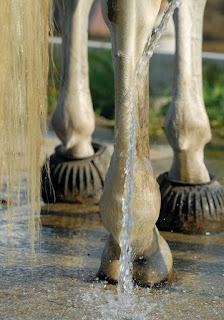Last week I had to have some posts replaced for the fencing
around the field. The fence has been in
place for just over 7 years now and because the soil is heavy clay it is not
ideal for wooden posts. The posts rot
and break off at ground level :(
I had a few replaced last year but some more have broken
this year, it will be an ongoing job I think.
However, it made me think about how happy and impressed I have been with
the fencing I chose.
As those of you who follow my blog or my You Tube channel will
know, Basil is a windsucker/crib biter.
Despite trying many different things with him in the nearly 10 years I
have owned him I have not managed to stop him.
He not only cribs in the stable but also in the field, where he finds a
post or rail!
Where I kept the horses previously the fencing was
traditional post and rail and after 2 years of Basil many of the top rails were
half chewed through – which looked very untidy and meant constantly replacing
them. As you can imagine when faced with
fencing in a new field I was keen to find an alternative. Now and in the past I have used electric tape to partition part of the
field off to limit grazing, but Chesney often went through this and it blew
down. I was not keen to put an
additional line of electric tape inside post and rail as that seemed excessive!
Whilst watching a video of Redwings Horse Sanctuary I
noticed they had some amazing fencing – which the narrator said was electrified
…. Horse Rail. So I looked into it more and found my solution.
At a distance the fencing looks like normal post and rail,
you can choose how many ‘rails’ you have – I just have 2. As it is flexible it also makes a really
smart curve, which post and rail fencing is not so great for. One side of my field is all curve!
The ‘rails’ are made from polyethylene so they don’t
splinter (another worry when Basil cribs), a wire is contained within the edge
of the fence which is then electrified.
This means that horses don’t lean on it or chew it! I also have a single ‘wire’ on posts around
the rest of the field which keeps the horses out of the ditch on one side. It runs inside the hedge on the 2 sides
because there are some thin places and I don’t want my horses running away.
The ‘rail’ is flexible so when a branch falls on it the
fence bends but is still in place, a wooden rail would break with the
possibility of escapees!
A couple of years ago Chesney rolled too close to the fence
and ended up with one leg under the bottom ‘rail’. If it had been wood he would have hurt himself
but because it was flexible he got his leg back under safely and managed to
roll back over.
I really am so pleased with the fencing I would recommend it
totally over any other type and it works out cheaper than post and rail
too.
This blog is NOT sponsored.
Have you seen last week's video 'Horses at home' on my You Tube channel?
Horse Life and Love. Please check it out and SUBSCRIBE.
You can also follow me on Facebook, Instagram and Twitter for updates on Chesney, Basil, Tommy and Daisy.
Until next time!
Jo
































